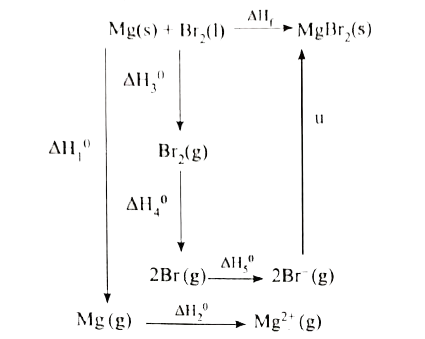When a mole of magnesium bromide is prepared from 1 mole of magnesium and 1 mole of liquid bromine, 524 kJ of energy is released. The heat of sublimation of Mg metal is 148kJ mol−1. The heat of dissociation of bromine gas into atoms is 193kJ mol−1. The heat of vaporization of liquid bromine is 31 kJ mol−1. The ionisation energy of magnesium is 2187 kJ mol−1 and the electron affinity of bromine is −662kJ mol−1. Calculate the lattice energy of magnesium bromide.Solution in Tamil
Given :
Mg(s)+Br2(l)→MgBr2(s) ΔH0f=−524KJ mol−1
Sublimation :
Mg(s)→Mg(g) ΔH01=+148KJ mol−1
Ionisation : Mg(g)→Mg2+(g)+2e− ΔH02=2187KJ mol−1
Vapourisaton :
Br2(l)→Br2(g) ΔH03=+31KJ mol−1
Dissociation :
Br2(g)→2Br(g) ΔH04=+193KJ mol−1
Electron affinity :
Br(g)+e−→Br−(g) ΔH05=−331KJ mol−1

ΔHf=ΔH1+ΔH2+ΔH3+ΔH4+2ΔH5+u
-524=148+2187+31+193+(2 x -331) + u
-524 =1897 + u
u=-524 - 1897
u=−2421kJ mol−1
Topper's Solved these Questions
- BOOK - FULL MARKSCHAPTER - THERMODYNAMICS EXERCISE - Additional Questions Solved (I)39videos
THERMODYNAMICS
- BOOK - FULL MARKSCHAPTER - THERMODYNAMICS EXERCISE - Additional Questions Solved (II)3videos
THERMODYNAMICS
- BOOK - FULL MARKSCHAPTER - THERMODYNAMICS EXERCISE - Textual Question Solved46videos
THERMODYNAMICS
- BOOK - FULL MARKSCHAPTER - SOLVED PAPER 13 (UNSOLVED)EXERCISE - PART-II9videos
SOLVED PAPER 13 (UNSOLVED)
Similar Questions
In which of the following process, the process is always non-feasible?
02:28View SolutionMatch the following
 08:53View Solution
08:53View SolutionDefine first law of thermodynamics.
01:26View SolutionDefine - equivalent mass.
04:03View SolutionOne mole of magnesium in the vapor state absored 1200kJmol−1 of enegry. If the first and second ionization energies of Mg are 750 and 1450kJmol−1, respectively, the final composition of the mixture is
02:28View SolutionCompute the heat of formation of liquid methyl alcohol in kJ mol^(-1) , using the following : Heat of vaporisation of liquid methyl alcohol =38 kJ mol^(-1) . Heat of formation of gaseous atoms from the elements in their standard states : H, 218 kJ//mol , C,715 kJ // mol, O, 249 kJ //mol . Averagebond energies : C-H, 415 kJ //mol ,C-O kJ //mol, O-H, 463 kJ //mol
View SolutionFor Br_2(l) Enthalpy of atomisation = x kJ/mol, Bond dissociation enthalpy of bromine = y kJ/mole, then
04:30View SolutionThe heats of vaporization of H_2 O, C_2 H_5 OH "and" CS_2 "are 40.6 kJ" mol^-1, 38.6 kJ mol^-1 "and" 26.8 kJ mol^-1 respectively. The strength of intermolecular forces in these liquids is in the order of __________.
04:38View SolutionOne mole of magnesium in the vapour state absorbed 1200 kJ mol^(-1) of energy . It the first and second ionization energies of Mg are 750 and 1450 kJ mol^(-1) respectively , the final composition of the mixture is
04:28View SolutionCompute the heat of formation of liquid methyl alcohol in kJ mol−1, using the following data. Heat of vaporisation of liquid CH3OH=38 kJ/mol. Heat of formation of gaseous atoms from the elements in their standard states , H, 218 KJ/mol , C, 715 KJ/mol , O, 249 KJ/molAverage Bond energies C -H , 415 KJ/mol , C – O, 356 KJ/mol , O – H, 463 KJ/mol
05:57View SolutionThe energy required to convert all atoms present in 1.2 g. magnesium to Mg2+ ions if IE and IE2 of magnesium are 120 kJ mol−1 and 240 kJ mol−1 respectively
03:31View SolutionCompute the heat of formation of liquid methyl alcohol in kilo joules per mole using the following data : Heat of vaporisation of liquid methyl alcohol : 38 kJ/mol.
Heat of formation of gaseous atoms from the elements in their standard states :
H = 218 kJ/mol,
C =715kJmol=andO=249kJmol.
Average bond energies,
C−H=415kJmol,C−O=356kJmolandO−H=436kJmol.02:48View Solutionएक मोल मैग्नीशियम, वाष्प अवस्था में 1200 kJmol−1 ऊर्जा अवशोषित करता है। यदि मैग्नीशियम की प्रथम एवं द्वितीय आयनन ऊर्जाएँ क्रमशः 750 एवं 1450 kJmol−1 हो तो मिश्रण का अन्तिम संघटन होगा
03:57View SolutionConstruct a Born-Haber cycle and use it to calculate the first electron affinity of chlorine. DeltaH_(atom(CI))= +122 kJ mol^(-1) " " DeltaH_(atom(Mg))=+148 kJ mol^(-1) DeltaH_("1st ionisation energy" (Mg))=+738 KJ mol^(-1) " " DeltaH_(2nd " ionisation cnergy"(MgCI_(2))= +1451 kJ mol^(-1) DeltaH _("lattice energy "(MgCI_(2))= -2526 kJ mol^(-1) " " DeltaH_(2nd " formation "(MgCI_(2)) =-641 kJ mol^(-1)
04:40View SolutionHeats of atomisation of chlorine and hydrogen are 243kJmol−1and435kJmol−1 respectively. Heat of formation of HCl is −92kJmol−1. Calculate the bond energy of HCL.
02:56View Solution

